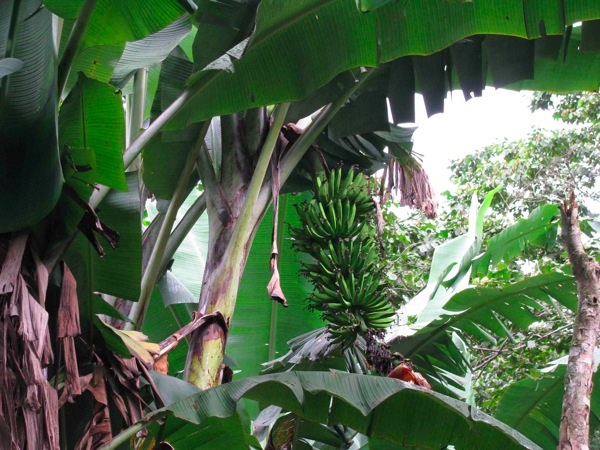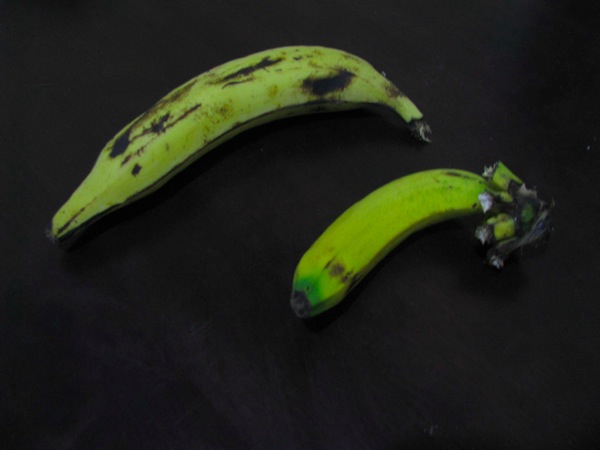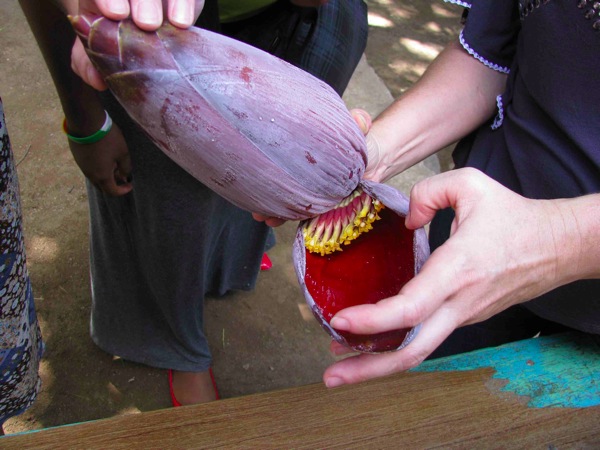Honduras is lleno (full) of complicated exports and their indelible effects on its history: coffee, minerals, and bananas. In this post, I’m going to focus on the latter.
(Also, there’s a great banana bread recipe at the end! Believe me, it’s delish.)

A bunch of bananas growing in the mountains outside of the Parque Nacional Montaña de Comayagua
– The plátano: the largest of the varieties, and always eaten fried, baked or cooked in soup but never raw. Composes an integral part of the plato típico (in combination with mantequilla, or cream) when mature and sweet. When fried in a less ripe state, they’re referred to as tajadas and taste more like french fries or chips.
– The banano: a more recognizable banana to us Northern folk. They vary in size depending on the variety.
– The guineo: the same as a banano, although usually used to refer to green unripe bananas.
– The mínimo: these adorably small fruits are super sweet, and hilarious to watch people eat. A one-bite banana.

A plátano, with a small banano (minimos are usually half this size)
The flores (flowers) hidden within the tree’s large buds can also be used to make a delicious sauce, when combined with various vegetables and spices. It’s a tedious dish to prepare, though: the stamens of the flowers must be pulled out individually as they are rubbery in texture, and the flowers are cooked twice.

Flores de huerta (garden flowers), as the women of Pespire called them.
But bananas are more than merely a dietary staple in this country. The two world leaders in banana production, Chiquita (formerly United Fruit Company, an amalgam of several other fruit producers) and Dole (formerly Standard Fruit Company), have battled for control on Honduran land for generations. Aside from political wrangling (including UFC-backed coup d’etat in 1910 [1]), the banana companies were notorious for their poor treatment of their workforce. Fighting against unpaid overtime, poor health and safety standards, 25,000 United Fruit workers and thousands of sympathizers from other industries across the country went on strike for 69 days in 1954. [2] Power imbalances have continued to the present, with closures of plantations and evictions [3], legal fights against the use of toxic pesticides [4] sneaky land acquisition [5] and confrontations between campesinos and the banana companies for land rights [6].

A Honduran banana shipping boat for Dole (aka Standard Fruit Company, aka Vaccaro Brothers & Co.) docked in San Diego; I snapped this shot during the ACS Conference (Mar 2012).
Today, Honduras still struggles with the legacy and burden of the banana, in social and scientific conflicts. The world banana production is built around a single strain, the Cavendish. While hardy, resistant to bruising, and sweet, the Cavendish has one significant flaw: the plants are susceptible to a fungus, one which has run rampant to the extent of threatening the world banana supply. Researchers at the Honduran Foundation for Agricultural Investigation are currently experimenting with different naturally-produced (ie. cross-pollinated and not genetically modified) combinations of banana varieties that might be able to withstand Racer Four, the pestilent fungus. So far, the efforts have been unsuccessful. [7]
To close off the heavy history and sensational peril of banana extinction, here’s the promised banana bread recipe. I have made around 5 loaves since I’ve arrived here, and the general consensus declares: “Está muy rico!”
Banana Bread (Recipe courtesy of my amazing friend Katie Butterill, farmer/owner of Smallholdings and baker extraordinaire).
Ingredients:
1 cup sugar
1/4 cup crisco/butter/margarine
3 mashed bananas
1 egg
1 tsp vanilla
2 cups flour
1 tsp baking soda
1 tsp baking powder
1 tsp cinnamon (as desired)
salt
handful of chocolate chips and walnuts, optional
– Cream sugar and butter
– Add bananas and mix well
– Add egg and vanilla, mix well
– Add sifted dry ingredients
– Mix in choco chips or nuts
– Bake in wax paper lined loaf pan (or greased/floured) for 60-70 minutes at 325˚F
Hackamore Brick – Oh! Those Sweet Bananas (Another apt contribution from Sarah S.’s awesome going-away playlist)
